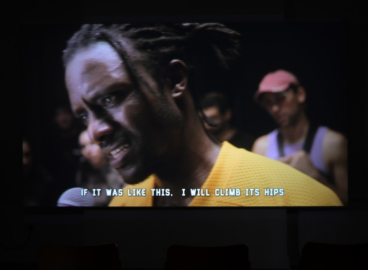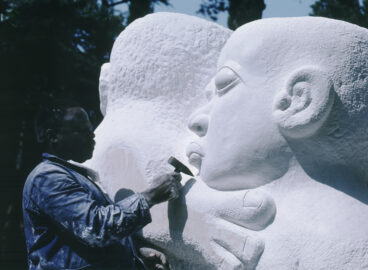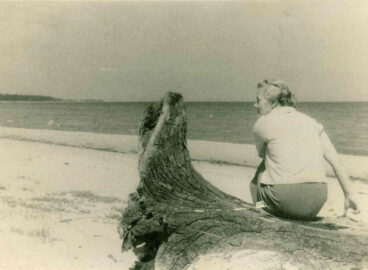A major new publication, Art and Theory of Post-1989 Central and Eastern Europe: A Critical Anthology, presents key voices of this period that have been reevaluating the significance of the socialist legacy, making it an indispensable read on modern and contemporary art and theory. The publication offers a rich collection of texts and an additional, reexamining perspective to its 2002 sister publication, A Sourcebook for Eastern and Central European Art since the 1950s, part of MoMA Primary Documents publications. For this new book, a series of conversations were commissioned with artists in the region and members of the C-MAP research group for Central and Eastern Europe at MoMA. The following is one of those dialogues, between Meghan Forbes and members of the group IRWIN.
Read a review of the new publication at Hyperallergic.

Meghan Forbes: The inextricable relation of art and politics is made explicit in the multidisciplinary output of the NSK, of which IRWIN was a founding member. In response to the violent dissolution of Yugoslavia in the early 1990s and the disintegration of communism in the region, NSK created the conceptual art project State in Time and has since operated as a sovereign state of sorts. With regards to the 1992 NSK Embassy Moscow, Eda Čufer and IRWIN wrote that “NSK confers the status of state not upon territory but upon the mind, whose borders are in a state of flux.” How does NSK reflect this tenet now, twenty-five years later?
Andrej Savski: I view the creation of State in Time a bit differently, not just as a response to the violent dissolution of Yugoslavia and the disintegration of communism, but rather as a creation of a new form and of a specific social community; it is rooted in the practice of collectivism that characterized the early NSK and which was accelerated through the activities of NSK citizens, such as those at the Berlin Congress and Folk Art Biennials. The tenet you are quoting is an important one that is still relevant and necessary for the preservation of potential possibilities of further open development. It is important to keep all options open, not only for us but also for the citizens.
Borut Vogelnik: It seems important to indicate which politics are inextricably related, and how they are related, to art. Even before establishing IRWIN, we were, as young artists, very interested in the conditions of art production and were entirely dissatisfied with the art system in the former Yugoslavia. We publicly disagreed with the policies enacted by art institutions and decided not only to create art but to build an independent support system for the art we were making, from the level of production to distribution, without the need to emigrate. This was new. It was possible only because of the political instability within the former Yugoslavia that manifested already in the early 1980s. It is the inextricable relation of the genre of painting and its immediate political context, the politics of the art system, both local and international, that significantly regulates how the work is perceived and positioned, that can be traced in IRWIN’s work from its inception until today.
Miran Mohar: IRWIN and the NSK groups were never political in the sense of daily politics. We never commented on such political issues in direct political language. But IRWIN projects like East Art Map, contemporary art collections, and other projects related to the construction of missing elements within the art system in Eastern Europe were truly political.
We established the NSK State as a communication channel to serve our goals. It became evident over time that many other people from other parts of the world identified with its principles, demonstrated by the fact that the number of NSK citizens has grown to over 15,000 since 1992. We can see a constant flux of various activities and projects of NSK citizens related to the NSK State in Time. Just to mention some of the most recent ones: NSK State Reserve in New York started issuing NSK money and bonds, and in the last four years, there were also two NSK Folk Art Biennials (Leipzig in 2014 and Ballyvaughan, Ireland, in 2016) presenting art related to NSK and its groups, as well as an NSK State in Time initiated and organized entirely by NSK citizens. Such an expansion of activity was not predicted, and it occurred without advertising from our state. In my opinion, the development of NSK State in Time went beyond our own expectations, and citizens took over in full. One can understand NSK State in Time as an experiment that is opening new possibilities of social organization beyond the physical borders of nation-states. The beauty of this project lies in the fact that its outcomes cannot be predicted. NSK State in Time is an artifact that has taken on a life of its own, independent of its original creators.
MF: It is interesting that you call NSK State in Time an “artifact.” There is a strong archival quality to the work of IRWIN, exhibited in its obsessive mapping, charting, and framing. Several past projects, such as the East Art Map volume and the Retroavantgarde installations hung in various exhibition spaces, are both a “re-make” (a term used by Borut Vogelnik in an interview conducted together with Miran Mohar for Alexandru Poglár in 2006) and a reappropriation of contemporary art-world and historical avant-garde imagery. IRWIN’s conceptualization of the relationship of the past to present seems less a Futurist-style rejection of all old models and more a process of collection and synthetic recontextualization of prior artistic strategies to confront directly the real social and political conditions within which you/we are operating currently. Do you conceive of IRWIN as creating a sort of living archive, prone to pedagogical ends?
BV: You are right; we did not act like the avant-garde was supposed to. We had good reason for this. If you want to reject the old model, you should define what that model is and find out who is controlling it, in order for that rejection to have any sense at all. The Slovene and Yugoslav art system was completely dependent on importing -isms from the West and adapting those imports to the local context. We publicly declared the art establishment irrelevant and provoked it to enter into open conflict with us. At the same time, we had begun to observe that in the East it was still possible to intervene in the field of articulation as a “private individual,” while elsewhere this was the exclusive domain of institutions.
AS: IRWIN is less the production of an archive and more the creation of constructs that exist in time. To my mind, projects such as Retroavantgarde and East Art Map are vehicles that suggest a parallel view and thus shape our understanding of the past or present.
BV: Retroavantgarde, which is presented and regarded as an artifact, is in fact a scheme of specific art production subsumed under the category Retroavantgarde. It presents the interrelations between a group of selected artists represented by their original works. Meanwhile, the East Art Map was never meant to be an art project; it was meant to be a map representing the art production within a certain territory, an orientation tool that we, being artists from the East, knew from our own experience to be important.
MF: To what extent does IRWIN and the NSK depend on a collective or community that extends beyond the group itself?
Roman Uranjek: IRWIN is one of the founding member groups of the larger NSK collective, established in 1984, a year after the IRWIN group had come into existence. Our idea took the perspective of the historical avant-gardes—such as the Bauhaus and postwar movements like Fluxus—as a starting point. The fundamental body of NSK consists of twelve individual persons. Through our activity, various poetics have been developed, and the working principle of every individual group has followed the rules of its own creative medium (music, theater, design, contemporary artistic practice, painting). And now, after more than three decades, we have twelve different notions and interpretations concerning the question of what NSK represents and whether it still exists at all.
MM: IRWIN is a collective with direct democratic decision-making, and NSK was always more of an initiative, an organizational umbrella of all groups rather than a collective in the true sense of the word. The formation of IRWIN and, later, NSK was partly also a substitution for the insufficiencies of the art system in the 1980s in Slovenia. We pooled our knowledge, skills, and economic resources. In the 1990s, relations between the various NSK groups became looser. NSK transformed into the NSK State in Time in 1992 as a decision of all NSK members. It is important to stress that each NSK group was always independent and that all groups have a different logic of functioning and decision-making, partly due to the nature of the mediums they work in. I can say that IRWIN understands the NSK State in Time as a sovereign community that independently uses the frame of the NSK State to realize its projects. IRWIN collaborates on various projects with individual NSK citizens or their groups.
BV: The results of the self-organization of NSK citizens are increasingly on display. It is important that NSKstate.com, the key domain where one can find information about NSK, was organized and managed by NSK citizens and not by the original Neue Slowenische Kunst. Communication between the citizens of NSK has developed around and through this internet project, and has gradually grown into joint campaigns and projects.
AS: We have always willingly collaborated with various communities, mainly on the project level. The Retroavantgarde project included collaboration with artists from the territory of Yugoslavia; East Art Map was done with the help of artists and curators from Eastern Europe; and the recent NSK Pavilion was probably the most complex collaborative project so far, which included what one might call an expatriate community of migrants, both artists and non-artists.
MF: In the introduction to East Art Map, published in 2006, IRWIN posits: “While it is true that a number of catalogues and books dedicated to various aspects of the contemporary art of the East have recently appeared, rather little has been done in the way of making serious comparisons between the Eastern and Western European context for art production. In this area, a no-man’s land continues to exist that divides one half of the continent from the other.” This “no-man’s land” is delineated cartographically in the volume as a large, blacked-out area where Eastern Europe would be. Do you still find this division to be palpable today, or are there more comparative, dialogical East/West approaches to the region that have cropped up over the last decade?
BV: Definitely a lot has changed regarding this question, not only with regard to an East/West axis in Europe, but globally. By drawing a map of undefined entities, you are in fact inventing them, and as far as I know there are only a few initiatives at present dealing with art on a global scale.
MM: The situation has partly changed for the better, but there are still substantial differences between Eastern Europe and the West. In Eastern Europe, there continues to be a strong dichotomy between the development of an art system—institutions, galleries, collectors, and art education (with some very honorable exceptions)—on the one hand, and high-quality art production (since the end of World War II through today) on the other. Recently, artists from Eastern Europe have figured in some of the most important international exhibitions. Since the art system has developed only partly (though the state of things is much better than it was before the 1990s), artists still have to count on galleries and support from abroad. Of course, the expansion of the EU makes things easier, but there is still a big economic difference, which, as we all know, also plays a major role in art. We were always aware of the fact that unless we organized ourselves, we will be organized by others. It is great to see that there are many individual and official initiatives that are making Eastern Europe more conducive to fostering contemporary art, increasing the possibilities of living and working here.
AS: While I don’t have much insight here, I am sure things improved a bit in the last decade. However, with regards to established hierarchies and the valorization of art from the West, I do not notice any substantial change.
MF: NSK has often drawn on symbols appropriated from totalitarian or extreme nationalist movements belonging to different political ideologies. Now that ideologies are more codified within a global system, what are your most salient forms for quotation and critique? Can you speak a bit, for instance, about the decision to create the NSK State Pavilion at the 57th Venice Biennale, in 2017?
MM: The iconography in IRWIN and NSK artworks was never iconodulistic. Different -isms and styles were always juxtaposed in our works. We said in the 1980s that we were painting -isms, art styles and symbols of political -isms, like Cézanne painted apples.
AS: We have often worked with images and symbols that have a strong activation potential. It is also true that over time and with repetition, the initial shock of provocative transgression lost its power. But I would say that what really interested us was not the provocation, since that is a statement in-relation-to, but the creation of a parallel form, a form that stands next-to, not necessarily against. In the case of the State in Time, it showed that this kind of reasoning actually had a bigger subversive potential, and not only in relation to the Slovene state but to the institution of the state as such.
BV: The decision to install the NSK State Pavilion at the Venice Biennale was intentional, but not intended to be a critique of the biennale itself, even if we understood that such a decision could not avoid being seen as one. Its specific organizational structure offered us a unique sociopolitical context in which it was possible to install the NSK State Pavilion side by side and in comparison with pavilions of other states. NSK State in Time has transformed into a community that started to live its own life. Although it is true that in terms of population size NSK State in Time cannot compare to most other states, one can claim that in terms of the structure of its citizens, it is already a superpower in the field of contemporary art. Its citizens include a number of exceptional, world-renowned artists, art theorists, and curators, for whom even the world’s most developed countries in this field would envy us. The NSK State Pavilion is, up to this point, the most complex installation of the abstract organism of NSK State in Time conducted in a physical space.
RU: When we decided to establish the NSK State Pavilion, we invited Zdenka Badovinac and Charles Esche to take over the curatorship of our pavilion. The curators decided to represent the idea of a state in which refugees participate and can issue passports. Ahmet Ögüt, a Kurdish artist living in Berlin, was entrusted with the visual representation of the state. The feedback from our colleagues, the visitors to the biennale, and the strong representation of our work across various media—including the BBC, CNN, Artforum, Financial Times, the Guardian—give us sufficient hope that we can continue with this project in the future.


